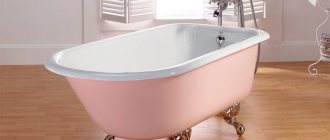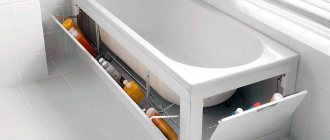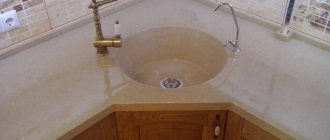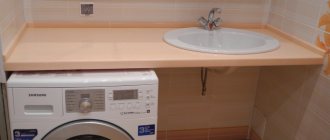A purchase like a bath requires the most careful approach. This is not an item that can be easily changed if something doesn’t fit. High cost, dimensions, the need for installation work - all this implies a purchase for many years. To choose the right bathtub, you need to focus not only on the appearance and size, but also on other characteristics that affect the durability, convenience and practicality of the product.
Which bath to choose
Types of baths
The main criterion for a bathtub is the material, but size, shape, thickness and coating play a big role. Conventionally, bathtubs can be divided into standard and luxury. Both have different features, but luxury bathtubs have features such as hydromassage and water purification.
Classic
Bathtubs are usually made of metal, cast iron and acrylic. If metal ones can only be oval or rectangular in shape, then you can choose any type of acrylic ones. The quality of the material and coating will depend on the cost. The less you pay for a bathtub, the less it will last you.
Superior baths
This category of bathtubs can consist of any existing material. Not only quality is taken into account, but also additional features - the presence of armrests, headrests, antibacterial cleaning and hydromassage nozzles.
There are quarry, glass, earthenware and marble baths. All of them are made of expensive material, so their price is higher than the classic ones. It is important to note the high quality of surface treatment, which protects the container from external damage and reduces the noise level of the collected water.
Life time
It’s not for nothing that cast iron products are still popular - after all, they are destined to please their owners for at least 50 years, and this is a very decent period. Steel bathtubs can safely last 20-30 years. Products made from cast acrylic last for at least 15 years. But provided that their walls have a thickness of at least 4 - 5 millimeters.
Cast iron bath
Steel bath
Acrylic bath
Results. Cast iron has firmly established itself in our leading position - its durability is beyond doubt (but technology must be followed in the manufacture of this material). Steel bathtubs are again in the middle of the ranking, and acrylic products are in last position.
Which bath material is better?
An acrylic bathtub consists of acrylic, divided into several components - ABS/PMMA and polymethyl methacrylate. The main part is ABS containing organic glass, the remainder comes from surface spraying with polymethyl methacrylate. Such baths are not expensive, but are very practical. When compared with other types, they are considered the lightest. This allows you to easily deliver them to your apartment and install them, which cannot be said about cast iron.
Cast iron bath: pros and cons
The cast iron bathtub can rightfully be considered a classic, since it was the one that was most popular in past years. Its peculiarity was durability, since the alloy does not rust or change shape. Also, the advantages include long-term heat retention. In an hour, the water temperature drops by no more than 15 degrees.
Cast iron bathtubs can be purchased both budget and expensive. Their difference will be based on the quality of the coating, since it plays a fundamental role. If the surface enamel is damaged, the bathtub will lose its beautiful appearance. If the damaged area is not restored in time, the spraying will quickly begin to peel off and spread over the entire surface. Disadvantages also include weight. On average, a cast iron bathtub weighs 150 kg, so you may encounter difficulties during delivery and installation.
Pros:
- warranty of at least 15 years;
- good heat transfer;
- low noise level.
Minuses:
- heavy weight;
- small selection of forms;
- lack of enhanced comfort functions.
Branded products differ in price compared to the budget class of Russian manufacturers. For the most part, this relates to the quality of the surface enamel.
Steel bath: pros and cons
Steel baths come in stainless steel and structural steel. Their difference is quite high. Stainless steels are expensive because rust will never appear on them, which cannot be said about structural ones. The advantages of both include ease of smelting. This means that you can choose any product in size and shape, with armrests and other additional features.
The disadvantages of steel bathtubs include the thinness of the walls, and the more bends on the bathtub, the more vulnerable it is. The coating is easily damaged by impacts, but is also easily restored. The noise level when drawing water is too high. A steel bath has poor heat transfer, so the water cools quickly.
Pros:
- light weight;
- a large variety of forms;
- low cost.
Minuses:
- tendency to deformation;
- vulnerable surface;
- high noise level when drawing water;
- low heat transfer.
A stainless steel bathtub will differ only in its service life.
Acrylic bath: pros and cons
This type of bath is the most common in our time. In addition to their light weight, they are as diverse as possible. Not only are there different shapes and sizes available to you, but also a wide range of colors. Since they are made of durable plastic, their service life sometimes reaches that of cast iron products.
The coating of the bathtubs consists of acrylic, so they are sensitive to chemicals and metal objects. When servicing them, you must adhere to the appropriate rules, otherwise the material will quickly lose its beautiful appearance.
Pros:
- a light weight;
- large selection of shapes and colors;
- long service life.
Minuses:
- a large number of low-quality models on the market;
- high sensitivity during maintenance.
When choosing an acrylic bathtub, you should carefully inspect the surface for minor damage.
Quaryl baths
Quaril is a combined material consisting of quartz, acrylic and special additives made from environmentally friendly materials. The uniqueness of quaril baths lies in their strength and long service life. The wall thickness reaches 20 mm, which makes the structure strong. But this factor also increases the weight of the bathtub; it becomes heavier than an acrylic model, but smaller than a cast iron model and the like.
To install a quaril bath, there is no need to call specialists; you can install the structure yourself. When servicing the bathtub, it is better to use a high-quality and appropriate chemical product, otherwise, after a certain period of use, the bathtub will lose its shine. Quaril structures also feature good heat transfer. They are inferior to cast iron, but superior to metal. The main disadvantage of such baths is their high cost.
Ceramic baths
This type of bathtub is distinguished by good heat retention and the absence of any mechanical damage. They are rarely found in the public domain as they are often made to order. During the manufacturing process, a special glazed coating is applied to the ceramics, giving the structure a shine. However, it is not sensitive to minor damage in the form of scratches.
The disadvantages of a ceramic bath include high cost and fragility. The structure weighs quite a lot, and the material can crack if subjected to a strong impact. For this reason, it is better to entrust delivery and installation to specialists.
Glass baths
These are some of the most expensive and luxurious baths. During the manufacturing process, the glass undergoes appropriate hardening, after which it becomes impact-resistant. The container is smelted from clean sand, so it contains no harmful elements. Glass bathtubs are often made to order.
Glass structures can be combined with plastic, but they are not valued because, with prolonged use, micro-leakages may appear at the joints.
Earthenware baths
The manufacturing process of such bathtubs is similar to ceramic products, but this type is very fragile. A faience bathtub is used not for washing, but for decorating the interior, since cracks can appear even from strong pressure. In addition to complex installation, you will need to regularly carefully maintain the product, otherwise it will quickly lose its presentation. This is one of the most expensive types of baths. The only advantages that can be highlighted are a large selection of unique shapes and good heat transfer.
Marble bath
This type of bathtub is divided into artificial and natural marble. They are similar in appearance, but the manufacturing process is fundamentally different. A natural marble bathtub is made from pieces of stone that are ground and fastened together. For this reason, the bathtub is expensive, but it does not last long. After some time of use, the marble will begin to turn yellow, and the areas glued together may develop microcracks.
Artificial marble consists of marble dust, acrylic and special additives. It stands out for its high strength and durability. Unlike natural marble, artificial marble does not change color with prolonged use and will retain its appearance depending on care.
Copper baths
Bathtubs made from copper were popular in the 19th century and are therefore considered classics. Their main advantage is not only in their unique appearance, but also in their characteristics. Copper is considered the best conductor of heat, so water will take a long time to cool. More often, bathtubs are made in large sizes for installation in the center of the room. If you have a small area, then a copper bathtub will not look so aesthetically pleasing.
This type of construction costs a lot of money, and maintenance also requires special attention. When washing and cleaning, do not use products with a scraping effect, as marks will remain on the soft metal.
Rating of bathtubs from the best manufacturers in 2022
Many people do not know which bath brand to choose; it is best to sort out the leading brands for each variety in order to understand who is the market leader. It’s logical to divide all the options according to the material of manufacture, this is the easiest way to figure it out:
- Ceramic products are represented by both the companies Globo and Flaminia, whose production facilities are located in Italy, and the Russian brands Colombo and Santek. The quality of all options is approximately comparable.
- Quaril is an exclusive development of Villeroy & Boch specialists. It is she who manufactures all products entering the Russian market. If somewhere they sell quaril from another brand, most likely it is cheap acrylic disguised as a more expensive material.
- Acrylic products are produced by a huge number of companies, so you can find products from all over the world. The most famous domestic brand is Aquanet. Among foreign manufacturers, we can note the German Duravit, the Dutch Riho, the Spanish Pool Spa, the Polish Cersanit and the Czech Ravak.
- Steel baths are made in many countries. In Russia, the most popular foreign brands are Slovakian Estap, Portuguese BLB, German Bette and Spanish Roca. It is also worth noting the products of the Lipetsk Pipe Plant and the Verkh-Isetsky Metallurgical Plant.
- Cast iron options are presented by only a few companies due to the complex production process. We can note the Spanish brand “Roca” already mentioned above and the French “Jacob Defalon”. As for domestic manufacturers, the best bathtubs are offered.
Important!
If it is difficult to find products from these companies in the region, then you should first study which brands are represented, and then read reviews about them on specialized resources. This way you can quickly find out the pros and cons of each manufacturer.
Which bathtub is better to buy: acrylic, cast iron or steel?
Cast iron bathtubs cost a lot of money, and their delivery and installation will be inconvenient due to their heavy weight, but they are durable and retain the water temperature well. When choosing a steel bathtub, the best option would be a stainless alloy, since the product does not rust. The metal version is often purchased due to its low cost, but it has many of the following disadvantages:
- poor water temperature retention;
- enamel sensitivity to damage;
- deformation.
An acrylic bathtub is the most practical. The advantage here is a large selection of products in terms of cost, size and color. Its light weight will allow you to mount it yourself, and the acrylic alloy will provide good protection from various damages.
Ultimately, the best option would be an acrylic bathtub as it has many benefits at a low cost. A cast iron bathtub has better technical characteristics, but it is too expensive for the average family, and is difficult to transport and install. Steel products are the cheapest, but are inferior to analogues in almost all respects.
Easy to care for
If the enamel is applied to cast iron with high quality and has a sufficiently thick layer, then the coating is very durable. And even if the stain has penetrated deep into the enamel, it can be removed in almost any way, including chemical reagents and mechanical action. And housewives do this with great success.
Steel products are coated with thinner enamel, which, accordingly, needs to be cleaned more carefully than in the previous case. Especially when using abrasive products. Otherwise, you can damage the surface, which will be difficult to restore later.
Acrylic bathtubs are cleaned carefully, using mild care products and without using strong abrasives or aggressive chemicals. This will prevent the formation of cracks and premature failure of the product.
Cast iron bath
Steel bath
Acrylic bath
Results. On this point, our products made of cast iron turned out to be the most unpretentious, and acrylic ones modestly retreated to the very last place, third. Steel baths took the middle position. However, the steel models mentioned above, coated with the innovative “Enamel-plus” composition, can also very well lay claim to the position of leader in ease of maintenance.
Compare straight and corner baths
The choice of a corner or rectangular bathtub depends on the size of the bathroom. If it is small, then it is important to install a rectangular product. This will allow you to save space.
Bathtubs of these shapes are the most common, which means their choice is quite large. If space allows, then as additional functions you can purchase a product with armrests and shelves for chemicals.
Corner baths will require more space, and their body will not allow you to hide hygiene products. However, due to individual shapes and increased sizes, such products are more expensive than rectangular ones. Before choosing one of the above baths, calculate the area and imagine its presence in the room.
Variety of sizes
Cast iron bathtubs made in Europe can have a length from 150 to 180 centimeters and a width from 60 to 90 centimeters. The standard length of the lower (inner) part is 110-120 centimeters. Modern technologies (changing the angle of the backrest, for example) make it possible to increase this size to 130-140 centimeters. Domestic cast iron bathtubs are made with a width of 70 centimeters and a length varying from 120 to 150 centimeters.
The variety of shapes of steel and acrylic products also implies a variety of sizes. As an example, let's take steel baths produced by the German company Kaldewei. The large model of this brand, Corpostar, has dimensions of 190 by 90 centimeters, and the small Miniform model has dimensions of 157 by 70 centimeters. The Japanese-style Kusatsu Pool model is distinguished by its increased depth (81 centimeters) and compactness (140 by 100 centimeters).
Bathtubs made from acrylic are equally varied in size. They can be large and small, wide and narrow, deep and not very deep. Corner and round options are available with different side sizes and diameters. If we talk about rectangular and oval models, their bowl can have a width from 70 to 170 centimeters, and a length from 120 to 190 centimeters.
Acrylic bath
Steel bath
Cast iron bath
Results. More modern steel and acrylic are again in the lead, leaving behind the good-quality but conservative cast iron. They make it possible to choose a product for any bathroom and for any purpose. For example, a large round bathtub can easily be used for two people at once. A compact corner option is for a small apartment.
Bath selection options
Your purchasing criteria will depend on your budget, the size of the room, and what additional features you need.
Choosing the size and shape of the bathroom
Almost all models have different shapes. Choose the size that suits your room, preferably with a small margin, otherwise there may be difficulties with installation. If you have a rectangular bathroom, then you need to buy a rectangular bathtub. In small square rooms it is important to install a corner one, as it will save a lot of space.
How to choose the length of a bath according to a person’s height
It is worth considering that bathtubs have their limitations in terms of shape and material of manufacture. For example, cast iron products can only be up to 170 cm, and to find the minimum option, you should look at steel bathtubs. Models with corner and similar shapes are made only from acrylic.
The main criterion when choosing a bath is the size of your room. But it is also important to choose a container according to the height of family members. Always look up to your biggest and tallest relative so that everyone can take a bath comfortably. For the average person, a model with a side height of up to 60 cm and a length of up to 180 cm is suitable.
Easy to install
Acrylic and steel bathtubs are considered the easiest to transport and install. Their weight usually does not exceed 40 kg, which allows you to install the structure yourself. The most difficult to fasten are cast iron and earthenware products. If the first ones are very heavy, then earthenware bathtubs are fragile and demanding. You can also select models made of copper, since you can install soft and not heavy metal yourself.
Thickness
The thicker the walls of the bathtub, the stronger it is, but the weight also increases. The wall thickness of quality products varies from 2 to 6 mm. If the characteristics indicate a lower figure, then the bathtub will wear out quickly, despite high-quality maintenance.
When choosing a product, always check its flexibility. Despite the material of the product, the walls and bottom should not spring or sag.
White and colored plumbing fixtures
The color of the bath will not affect its longevity or quality in any way. More often we see white products, since since ancient times this color has been a symbol of cleanliness and hygiene. On white plumbing, stains and smudges will be immediately visible, which need to be cleaned immediately.
Durability of structure and frame
Depending on the thickness and material of the bathtub, an appropriate design is installed. Before purchasing, you can determine in advance the strength of the sides based on the number of pallet legs. High-quality products are usually mounted on metal frames with four legs at the corners. For thin acrylic or metal, a reinforced frame is installed that supports most of the sides. This means that the product is capable of deformation.
Inner coating
There are several options for bathtub coverings. The most common are enamel and acrylic. Metal and cast iron products are coated with enamel. Its service life is no more than 5 years, so enameled bathtubs are less valuable. Acrylic, on the contrary, can be used for up to 12 years.
After prolonged use, the walls of the bathtub can be restored independently or with the help of specialists. The procedure for applying a new coat of enamel is simple and cheap, but you have to adapt to painting. Restoring acrylic will be more expensive, but there are several methods:
- Applying a layer of acrylic to the surface of the bathtub using a brush and a preliminary cleaning procedure.
- Applying an acrylic insert will make the surface of the product new in a short time, but this method is more expensive.
Acrylic is of higher quality and more beautiful than enamel, but more expensive to maintain.
How to decide on the manufacturer
The name of the plumbing ware manufacturer plays an important role when purchasing, since a reputable brand produces quality products and provides a high level of service. Little-known companies can also produce good products, but this is not a fact. The buyer takes a risk by choosing a bathtub with many features at a low cost.
Let's immediately highlight Russian manufacturers. These include the Verkh-Isetsky plant, the Lipetsk pipe plant, which also produces high-quality products.
Among the foreign brands, it is immediately worth highlighting the German company Villeroy & Boch, since it is the only one that produces bathtubs from quaril. High-quality sanitary ware is produced by the Spanish company Roca. This is one of the most common bathtub manufacturers on the domestic market. The list of the best companies includes:
- Cersanit (Poland);
- Duravit (Germany);
- Ravak (Czech Republic);
- Riho (Holland).
Other brands are not so well known in Russia, so the quality of their products is questionable.
What to look for in a store when purchasing
First of all, pay attention to the external and internal coating of the product. There should be no scratches or bulges on it. Test the sides and bottom of the bathtub for flexibility, as thin walls will lead to deformation. It is also worth paying attention to the shape of the frame. If its design covers the entire bathtub, then it is not advisable to purchase it.
The next criterion will be ease of use. If you want to purchase a product with a lot of additional functionality, for example, hydromassage, then choose branded products, since the Chinese manufacturer does not stand out for quality and durability.
The purchase of a bathtub will also depend on the presence of children in the family. In this case, avoid deep and wide containers to protect the child’s bathing. It is also recommended to choose models with anti-slip coating.
Equipment
The bathtub configuration is divided into standard and improved. In the first case, only instructions are included with the product. The improved package includes various panels, a frame, a set of parts for draining and overflowing water.
Soundproofing a steel bath
It is known that the noisiest bathtubs are steel ones. The thinner the product, the louder the water will be drawn. Models with a case thickness of 4 mm or more are not as loud, but there is still noise. You can see steel bathtubs on the market with additional outer shells that absorb sound, but there are also many ways to reduce the noise level yourself.
Weight
Cast iron products are the heaviest. It is almost impossible to transport and install them yourself, but they are the most durable and strong. If you need a lightweight bathtub, then the choice needs to be made between acrylic or metal. The weight of the product usually does not exceed 40 kg and they are easy to move and attach. Bathtubs made of ceramics, marble and glass are also heavy, but also more fragile.
Additional functions
This factor will significantly affect the level of comfort and cost of the product. Only for built-in massage, the system includes an air compressor, hoses, tubes and nozzles. The complexity of the mechanism increases the cost of the bath. More expensive models have water disinfection functions, aromatherapy, armrests and headrests.
Luxury products have a built-in touch display that allows you to see the water temperature and time. Using it, you can set the pulse of the air supply nozzles, increase or decrease the jet power, and also set and save your own massage options.
Bathtubs with hydromassage require appropriate care. They need to be cleaned with special means, water must be supplied only through a purification filter, and when bathing you cannot use hygiene additives such as sea salt and foam.
How to choose the optimal size bathtub
Having decided on a certain material and color scheme, they move on to choosing the optimal size of plumbing fixtures.
In this case, it is worth taking into account four main parameters:
- The height of the side above the floor level;
- Bowl depth;
- Bowl length;
- Bowl width.
The height of the plumbing fixtures is determined based on the average height of family members and also takes into account whether there are children among the household members. For an adult, the optimal height is considered to be 65-70 cm. However, if there are small children in the family, it is better to choose a lower bathtub.
The depth of the bowl is the distance from the bottom of the font to the top edge of the side or overflow siphon. When determining the depth, it is important to take into account the fact that when filled, the water should completely cover the lying person. On average, the optimal depth is considered to be 50-60 cm.
The length and width of the bathroom are selected based on the individual characteristics of family members. The average length of the font is 150-180 cm, and the width is 70-80 cm, however, these data are calculated for a person 170-180 cm tall and not prone to being overweight.
The position of the human body depending on the size of the bathtub.
Now let's talk about the sizes of bathtubs made of specific materials.
1. Cast iron bathtubs are presented on the Russian market in two categories: miniature 70 by 120 cm, sometimes miniature sanitary ware with a length of 130 cm appears on sale; and bathtubs of the European standard category, with a length of 140-150 cm and a width of 70 cm. As you can see, cast iron bathtubs are very limited in the variety of bowl dimensions.
2. Steel bathtubs are made with a bowl length of 150-180 cm and a width of 70-85 cm. Sometimes there are bathtubs made of economy class steel. This is more likely to save not money, but space in the bathroom, since the length of the font can be only 120 cm.
3. Acrylic bathtubs offer the consumer the widest possibilities. On sale you can find models with a long bowl of 120-190 cm, and a width of 70-170 cm. Much depends on the shape and overall configuration.
4. Ceramic bathtubs with a classic oval bowl most often have the following dimensions: length 130-170 cm and width 65-75 cm. Again, a lot depends on the configuration of the plumbing.
Installation types
All existing baths are divided into three types of installation, each of which has its own installation technology.
| type of instalation | Short description |
| Free standing or free standing | It is recommended to install such models only in spacious rooms, since their design involves installation separate from the walls. |
| Built-in | After installation, the bathtub becomes compact and barely noticeable, but its installation is quite complicated. To do this, you must first create a niche in the floor or wall. |
| Wall and corner | The most common types of baths. They are mounted close to the wall. Regardless of whether the product is corner or wall-mounted, it can stand either on its own structure or on metal legs. |
Ease of use
Here we will consider what degree of comfort products made from various materials give us. Let's start with the temperature of the water - for a pleasant swim it is important that it does not cool down longer. Good old cast iron is very good in this sense - it keeps water warm for a long time. However, modern acrylic can also boast of good heat conservation. But steel - alas - quickly cools water. In addition, it has another drawback - it rattles loudly when the bath is filled. Cast iron and acrylic are very quiet.
Bathroom walls made of cast iron will never sag. Now let’s look at the following two products based on this parameter, determining which bathtub is better—an acrylic or a steel bathtub. Steel can easily hold its position without sagging under the weight of the body, which cannot be said about acrylic. Deflection of the walls is its main drawback; the metal frame on which the bathtub is mounted is designed to cope with it. This is most relevant for overweight people.
Cast iron bath
Acrylic bath
Steel bath
Results. According to the parameters under consideration, the most convenient are cast iron products. Acrylics are not without drawbacks in this regard, so they can share second place. Steel bathtubs are somewhat inferior to acrylic bathtubs in this regard, but in some cases they can perform on an equal footing. Also, bathtubs made of steel and acrylic are often equipped with all sorts of comfortable seats, handles, and armrests.
Tips for choosing a manufacturer
Not only foreign manufacturers are in demand on the domestic market. Competition for global brands comes from domestic manufacturers such as Aquanet, 1 Mark and Bas. They do not have a large selection of bathtubs, but the models they produce stand out for their good quality and durability.
In the list of the world's best companies, the first place is occupied by the German manufacturer Villeroy and Bosch. This brand produces sanitary ware made from the unique material Kvarila, which competitors do not have. If you need a universal bathtub shape, then we recommend looking at Czech products, which produce more than 200 different types of bathtubs, differing in shape, material and function. The most expensive products are produced by Italian. It has been around since the 18th century, so you can buy classics made of copper or wood.
Before buying a bathtub, immediately look at its manufacturer, because, despite the large list of functions, the product can quickly lose its marketable appearance. Depending on your budget, you can purchase bathtubs from both Russian and foreign manufacturers. Check the product for cracks and scratches. There are more than a dozen varieties of materials from which bathtubs are made. They all have both advantages and disadvantages, so weigh the pros and cons carefully. Choose the most suitable size and shape, and only then pay attention to the color and additional functions.
Additional capabilities of baths and the advisability of their use
The availability of additional functions in its design may directly depend on the material from which the bathtub is chosen.
- Cast iron or steel bathtub – additional options, most often not available.
- Bathtub made of acrylic or quarry - depending on the model, hydromassage, aeromassage, chromotherapy, an empty bathtub disinfection system and a water level sensor can be built-in.
Hydromassage
Hydromassage is realized through the operation of a special installed pump, which pumps water into the nozzles provided in the walls of the font. As a result, the filled bath produces the effect of water flow. This has a beneficial effect on the human body, producing relaxation and improving tone.
Aeromassage
Aeromassage, like hydromassage, is produced thanks to the operation of a low-power electric pump. The only exception is that the nozzles located on the walls of the bath deliver not a stream of water, but oxygen bubbles. Often, plumbing fixtures that combine both aeromassage and hydromassage are called in one word - jacuzzi.
Chromotherapy
Chromotherapy is a system designed to increase overall tone, improve the functioning of blood vessels and have a weak antibacterial effect on the human body. The principle of chromotherapy is the operation of violet lamps in special reflectors during water procedures. The “blue lamps” built into the walls of the font illuminate the body of a lying person from all sides.
The auto disinfection system is an additional option, which, after taking a bath and draining the water, delivers a disinfectant to the walls of the font through special holes, which is later automatically washed off by the system itself.
Water level sensor - in principle, an adult does not need it. The main task of the sensor is to determine how full the bath bowl is with water, since if, for example, you turn on the hydromassage or air massage when the bath is empty, then the main pump and all systems can quickly fail. The water level sensor, in turn, simply will not turn on the hydromassage when the bowl is empty.
Device weight
The heaviest are bathtubs made of cast iron. They weigh at least 120-130 kilograms. Such a significant weight (sometimes reaching up to 150 kilograms) provides good stability, but significantly complicates installation work. Which will cost more than installing a steel or acrylic bathtub.
A European-made steel bathtub with walls from 2.5 to 3 millimeters is much lighter than a cast iron one, several times lighter. Her weight is approximately 25 to 30 kilograms.
The most “weightless” material can be called acrylic. If a bathtub made from it has a length of 150 centimeters, then its weight ranges from 15 to 20 kilograms. Products with a length of 170 centimeters weigh from 20 to 25 kilograms. By the way, when purchasing, pay attention to this: a bath that is too light, and whose weight differs greatly from these indicators, may turn out to be of poor quality. Otherwise, the manufacturer cheated by making a product with fewer reinforcing layers than it should have.
Acrylic bath
Steel bath
Cast iron bath
Results. In first place we will define acrylic products. On the second - steel baths, and on the third - cast iron, completely heavy.











